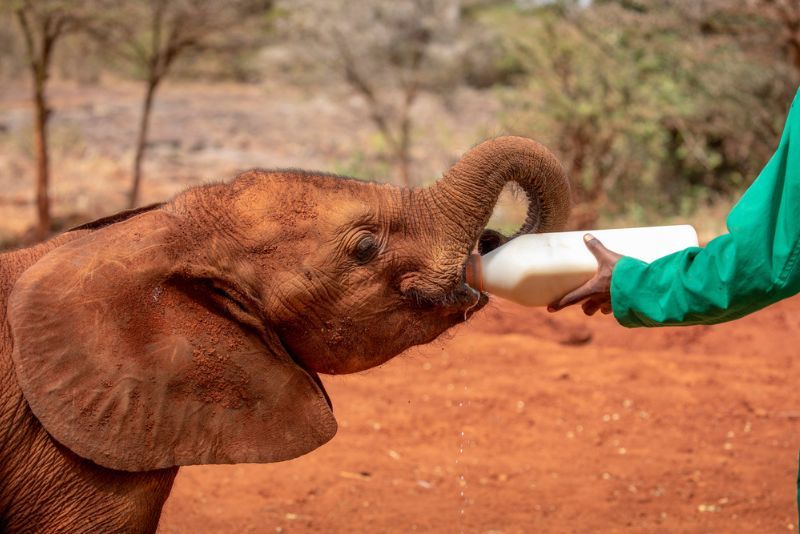Sheldrick Elephant Orphanage: Tickets and Tours
The Sheldrick Wildlife Trust's elephant orphanage provides a haven for some of the most vulnerable creatures in the savannah — calves who have lost their mothers through human interference or loss of habitat. The trust behind this facility is dedicated to the rehabilitation and reintroduction of these mammals to the wild, and are educating others on how to best protect the species.
By joining a Sheldrick Elephant Orphanage tour, you’ll be able to see these spectacular beings up close and learn why their preservation is so important to the African wilderness.
The Sheldrick Wildlife Trust's elephant orphanage provides a haven for some of the most vulnerable creatures in the savannah — calves who have lost their mothers through human interference or loss of habitat. The trust behind this facility is dedicated to the rehabilitation and reintroduction of these mammals to the wild, and are educating others on how to best protect the species.
By joining a Sheldrick Elephant Orphanage tour, you’ll be able to see these spectacular beings up close and learn why their preservation is so important to the African wilderness.

(0/24) checking Musement...
The Sheldrick Wildlife Trust's elephant orphanage provides a haven for some of the most vulnerable creatures in the savannah — calves who have lost their mothers through human interference or loss of habitat. The trust behind this facility is dedicated to the rehabilitation and reintroduction of these mammals to the wild, and are educating others on how to best protect the species.
By joining a Sheldrick Elephant Orphanage tour, you’ll be able to see these spectacular beings up close and learn why their preservation is so important to the African wilderness.

Here's all you need to know about Sheldrick Elephant Orphanage, one of the most captivating attractions in Nairobi.
How much do Sheldrick Elephant Orphanage tickets cost?
The fee for Sheldrick Elephant Orphanage tickets counts as a donation toward the Sheldrick Wildlife Trust, and is used to extend its conservation efforts, whether that’s through providing care for the elephants on site, attending veterinary emergencies on the savannah or deterring poachers.
When purchasing Sheldrick Elephant Orphanage tickets, you should bear in mind that you will also be required to pay the Nairobi National Park entry fee, which is charged at US$43 per adult and US$22 per child for foreign visitors.
Sheldrick Elephant Orphanage tickets:
- Adults (ages 12+): US$20
- Children (under 12): US$5
Should you book in advance?
It is mandatory to book your Sheldrick Elephant Orphanage tickets in advance, either through the official website or through a tour provider. If choosing to purchase through the nursery’s official website, you will need to pay in cash for your tickets on the day.
However, those who choose a prearranged Sheldrick Elephant Orphanage tour will benefit from easy payment online, meaning their experience in Nairobi will be seamless. By booking in advance, you’ll guarantee entry on a day of your choosing, enabling you to shape the rest of your vacation itinerary around this memorable excursion.
What are the best Sheldrick Elephant Orphanage tours?
Private Sheldrick Elephant Orphanage tour

On a private Sheldrick Elephant Orphanage tour, you’ll have the opportunity to get close to the gentle giants, watching them interact with each other in a safe environment. You’ll learn about the conservation efforts of the team behind the nursery, as well as the history of the organization, which dates back 40 years and was the first elephant orphan rescue and rehabilitation operation in the world.
Admire the elephant’s regal movements as they wander slowly through the reserve before watching as they roll around in pools of mud — an elephant's idea of a luxurious bubble bath. Then, once you’ve gained an introduction to these creatures, you’ll be transported back to your hotel to spend the rest of the day relaxing or head out into the city for a spot of sightseeing.
Are there any combined tickets or tours including Sheldrick Elephant Orphanage and other attractions?
You can choose from several combination Sheldrick Elephant Orphanage tours, which enable you to save both money and time versus booking several separate excursions.
● Sheldrick Elephant Orphanage and Giraffe Center tour: Discover the rehabilitation efforts of the Sheldrick Elephant Orphanage before experiencing a bucket-list moment at the Giraffe Center, feeding the endangered Rothschild Giraffe.
● Sheldrick Elephant Orphanage, Giraffe Center and Karen Blixen Museum tour: After an early morning game drive to see the “Big Five” at their most active, you’ll hop between the Sheldrick Elephant Orphanage and the Giraffe Center, finishing up at the Karen Blixen Museum to learn about Kenyan culture.
● Guided tour of Sheldrick Elephant Orphanage and Giraffe Center with Bomas of Kenya visit: Gain a well-rounded view of Kenya by exploring its safari animals alongside a performance at the Bomas of Kenya, which showcases the very best of the country through music and dance.
What will you see?

The Sheldrick Elephant Orphanage serves as a refuge for young animals who have lost their mothers to poaching or loss of habitat. While visiting here, you will be able to see the animals in a safe environment, playing with each other and being fed by their guardians.
During your visit, one of the lead keepers will fill you in on the personal stories of the orphans in their care, as well as the trust's conservation efforts. You will be able to ask questions at the end.
The Sheldrick Wildlife Trust has been running for over 40 years and, in that time, has raised more than 300 orphans who have been reintegrated into the wild after extensive rehabilitation. Of these, more than 50 elephants have gone on to become mothers to their own calves.
While the Sheldrick Wildlife Trust’s main hub is located within Nairobi National Park, the team works across the country to provide young elephants with the care they desperately need in order to live long and healthy lives.
On top of rehabilitation, Sheldrick Wildlife Trust also employs several mobile veterinary units, and has responded to almost 11,000 cases, of which more than 3,000 were for elephants. Many of the injuries caused in the wild are due to human interference, from gunshot wounds to spear lacerations and snares.
An anti-poaching unit also helps to protect the savannah and destroyed over 22,000 snares in 2022 alone. Almost 1,000 arrests have been made because of the team’s efforts to end illegal poaching, either for ivory, keratin or bushmeat.
Alongside elephants, the trust also protects black and white rhinos, who are often poached for their keratin horns, as well as giraffes. The African elephant, which is the creature you’ll see by purchasing Sheldrick Elephant Orphanage tickets, has a lifespan similar to that of a human, living to approximately 70 years of age when not threatened.
They can be found in more than 30 countries across Africa, including Botswana, Namibia and Tanzania, and are classed as either endangered or critically endangered depending on whether they live on the savannah or in the forests of the continent. There are approximately 400,000 African elephants left and the population has shrunk by 90% over the course of the last 500 years.
How to get there?
The Sheldrick Elephant Orphanage is located within Nairobi National Park, the entrance of which is less than 10 kilometers south of Nairobi city. In order to enter the national park, you must remain in a vehicle at all times, meaning the best way to reach the attraction is by car.
To reach the site, you’ll leave Nairobi in a southerly direction along Langata Road. You’ll then merge onto Magadi Road and enter the national park through the KWS Magadi Gate.
Those without access to a car can either book a taxi to take them to the orphanage or arrange a guided Sheldrick elephant orphanage tour, which includes a convenient hotel pickup service.
What are the opening times?
Visitors can discover Sheldrick Elephant Orphanage every day between 11 AM and 12 PM except on Dec. 25.
Is it wheelchair friendly?
Because of the nature of the attraction, Sheldrick Elephant Orphanage is not wheelchair friendly. Instead, those with limited mobility can choose from a wide range of attractions in Nairobi that are more accessible.
When is the best time to visit Sheldrick Elephant Orphanage?
The best time to visit the Sheldrick Elephant Orphanage is in the dry seasons of January to March and July to October. These periods can be more comfortable as there will be less mud and fewer mosquitoes. Visiting on a weekday may also be preferable to the more crowded weekends.
It's advisable to arrive at 10:30 AM in order to allow enough time to pass through the gate before the viewing slot at 11 AM.
Travel tips
- Remember that the elephant orphanage has a clear mission to rehabilitate these animals, so it’s important to be respectful and follow the rules set by the sanctuary.
- Wear comfortable clothing and footwear for being outside. Don’t forget to carry some sunscreen, a hat, and some water as it can get quite hot. Do not bring other drinks or food.
- During the visit, phones must be switched to silent so as not to disrupt the experience.
- Visitors are not allowed to feed or directly interact with the elephants. Minimal human contact is vital in order for them to be reintegrated into the wild.

